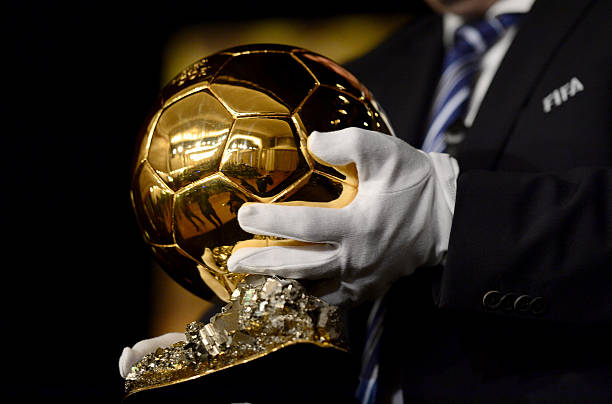A jornada da Bola de Ouro FIFA começa na Europa pós-guerra, uma época em que o continente buscava unidade e celebração através do esporte. Inicialmente destinada a jogadores europeus, a Bola de Ouro rapidamente se tornou um fenômeno global.
Em 1995, a inclusão de jogadores de clubes fora da Europa ampliou o seu alcance, tornando a competição verdadeiramente mundial. A fusão temporária com o prêmio da FIFA entre 2010 e 2015 apenas reforçou seu status como o ápice das conquistas individuais no futebol.
Quando falamos em futebol, algumas imagens vêm imediatamente à mente: gols espetaculares, torcidas apaixonadas, e claro, a gloriosa Bola de Ouro. Este prêmio, cobiçado por jogadores de todo o mundo, não é apenas um troféu; é um símbolo de excelência e conquista no universo do futebol.
Browse the content

Critérios de Votação e Seleção: Como se Ganha a Bola de Ouro FIFA
Você pode se perguntar: como um jogador ganha a Bola de Ouro? Bem, não é nada fácil. A escolha envolve um processo de votação meticuloso onde jornalistas esportivos de todo o mundo enviam seus votos, escolhendo três jogadores que, em sua opinião.
foram os melhores do ano. Cada voto é ponderado, com pontos atribuídos de acordo com a classificação, e o jogador com a maior pontuação total leva para casa a Bola de Ouro FIFA.
Vencedores Notáveis e Recordes: Os Gigantes da Bola de Ouro FIFA
A história da Bola de Ouro está repleta de nomes lendários. De Alfredo Di Stéfano a Johan Cruyff, de Michel Platini a Cristiano Ronaldo e Lionel Messi, os vencedores representam uma lista dos quem é quem no futebol mundial. Lionel Messi, com sete vitórias, detém o recorde de mais Bolas de Ouro ganhas, um testemunho de sua genialidade e influência duradoura no esporte.
Impacto Cultural e Econômico: O Poder da Bola de Ouro FIFA
O impacto da Bola de Ouro vai muito além do campo de futebol. Ganhar este prêmio pode transformar completamente a carreira de um jogador. Os vencedores frequentemente experimentam um aumento significativo no seu valor de mercado.
com clubes dispostos a pagar prêmios altos para assegurar os serviços de um “Melhor do Mundo”. Além disso, os patrocinadores e marcas correm para associar seus nomes aos portadores da Bola de Ouro , esperando capitalizar sua popularidade e imagem de excelência.
Culturalmente, a Bola de Ouro tem um papel igualmente monumental. Ela celebra e promove o talento individual dentro de um esporte coletivo, muitas vezes criando heróis globais cuja fama transcende o futebol.
Estes jogadores tornam-se ícones culturais, influenciando moda, música e até política. O prêmio também reflete e às vezes influencia as tendências táticas e técnicas no futebol, com os treinadores buscando moldar suas estratégias para maximizar o potencial de futuros candidatos à Bola de Ouro FIFA.
Categoria Feminina: Igualdade na Bola de Ouro FIFA
Um dos desenvolvimentos mais significativos recentes na história da Bola de Ouro foi a introdução da categoria feminina em 2018. Essa mudança foi um passo crucial para reconhecer e valorizar o talento no futebol feminino.
Jogadoras como Ada Hegerberg, Megan Rapinoe e Alexia Putellas não apenas ganharam a Bola de Ouro , mas também usaram a plataforma para advogar por igualdade de gênero e melhores condições no esporte feminino. Este prêmio trouxe uma visibilidade sem precedentes ao futebol feminino, inspirando uma nova geração de meninas a jogar e seguir suas paixões.
Impacto Cultural e Econômico: O Poder da Bola de Ouro FIFA
O impacto da Bola de Ouro FIFA vai muito além do campo de futebol. Ganhar este prêmio pode transformar completamente a carreira de um jogador. Os vencedores frequentemente experimentam um aumento significativo no seu valor de mercado.
com clubes dispostos a pagar prêmios altos para assegurar os serviços de um “Melhor do Mundo”. Além disso, os patrocinadores e marcas correm para associar seus nomes aos portadores da Bola de Ouro FIFA, esperando capitalizar sua popularidade e imagem de excelência.
Culturalmente, a Bola de Ouro FIFA tem um papel igualmente monumental. Ela celebra e promove o talento individual dentro de um esporte coletivo, muitas vezes criando heróis globais cuja fama transcende o futebol. Estes jogadores tornam-se ícones culturais.
influenciando moda, música e até política. O prêmio também reflete e às vezes influencia as tendências táticas e técnicas no futebol, com os treinadores buscando moldar suas estratégias para maximizar o potencial de futuros candidatos à Bola de Ouro FIFA.
Categoria Feminina: Igualdade na Bola de Ouro FIFA
Um dos desenvolvimentos mais significativos recentes na história da Bola de Ouro FIFA foi a introdução da categoria feminina em 2018. Essa mudança foi um passo crucial para reconhecer e valorizar o talento no futebol feminino.
Jogadoras como Ada Hegerberg, Megan Rapinoe e Alexia Putellas não apenas ganharam a Bola de Ouro FIFA, mas também usaram a plataforma para advogar por igualdade de gênero e melhores condições no esporte feminino. Este prêmio trouxe uma visibilidade sem precedentes ao futebol feminino, inspirando uma nova geração de meninas a jogar e seguir suas paixões.
Conclusion
A Bola de Ouro FIFA é mais do que apenas um prêmio; é uma instituição que tem moldado a face do futebol mundial. À medida que avançamos, a continuidade de sua relevância dependerá de sua capacidade de adaptar-se e responder às mudanças no esporte e na sociedade. O legado da Bola de Ouro FIFA é indiscutível, mas seu futuro será determinado pela forma como enfrenta os desafios e mantém sua posição como o prêmio de maior prestígio no futebol.